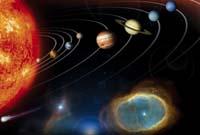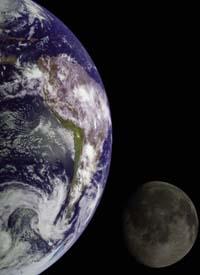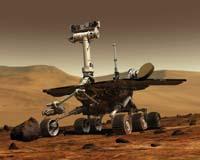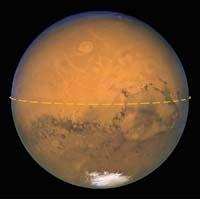House of life
2008/06/01 Kortabitarte Egiguren, Irati - Elhuyar Zientzia Iturria: Elhuyar aldizkaria

In 1978 astrophysicist Michael Hart made a series of calculations that concluded that: The Earth would not be a good place to live if 1% of the Sun is removed or 5% approaches. However, over time, once these data have been revised, it can be affirmed that they are somewhat more generous. In other words, there would be problems for life on our planet if 15% of the Sun is removed or 5% approaches. However, it is not thought that the difference is great, it is still scarce.
Venus is a clear exponent of this little difference. Of size and composition similar to the Earth, it is located 40.000 million kilometers from the Sun. The Earth is about 150 million kilometers from the Sun and Venus 110 million kilometers away.
The energy of the Sun comes two minutes before us, and this excess heat made the planet not able to store water on the surface, which caused the accumulation of carbon dioxide in the atmosphere and the increase of the greenhouse effect. In addition, it is not very clear, but by evaporating that water the ultraviolet rays of the Sun dissociated the water vapor and the hydrogen atoms were dispersed by the space dragged by the solar wind, while the oxygen atoms, once combined with carbon, formed more carbon dioxide, until Venus asphyxiated.

The current temperature is 470ºC (enough heat for lead to also build) and the pressure on the surface of Venus is 90 times higher than the terrestrial atmospheric pressure (greater than the human body could bear). The problem is that if we approach the Sun. If we move away, the problem would be cold, as it happens on Mars. The water that could be in it would be icy.
Therefore, the situation of the planet and, therefore, the temperature guarantee the presence of liquid water and the presence of living beings. And it is that water (in liquid state, of course) is an indispensable element for living beings.
Measure of life
In addition to localization, the characteristics of the Earth contribute to the development of life. Surely if we ask a child about the size of the Earth, he will respond that it is large. The astronauts who observe from space see our planet small. However, the size or mass of the Earth is large enough to have an atmosphere that protects us from the harmful radiations we can receive from the Sun or from other stars.

On the other hand, these planets rapidly lose the surplus energy of the generation process and are often said to be geologically dead. They do not have volcanoes, earthquakes or significant geological activities. All of them provide the terrestrial surface with basic materials for life and one of the temperature moderators, carbon dioxide, to the atmosphere.
All these geological activities can be explained on Earth with the help of the theory of plate tectonics. This theory explains how the tectonic plates of the Earth move (they move 2,5 cm per year at the same speed as the nails grow in the hands) and why volcanoes and earthquakes only occur in certain places of the planet.

This dynamism of the Earth, in addition to surface, can be observed in the core (at a depth of approximately 3,000 kilometers). In this area, metals predominate, mainly iron and nickel, which influence the development of life on Earth. They are responsible for the magnetic and electrical phenomena that characterize our planet. The Earth has a powerful magnetic field, as if the planet had a magnet in the background, which, along with the atmosphere, protects us from harmful radiations coming from the Sun and space in general.
In addition to the proper location of the planet and its characteristics, Earth needs a key element that equips the planet to continue its current life: The moon.
Additional satellite
According to some scientists, without the Moon life on Earth would not be possible, at least what we know today. Most moons are small compared to their planets: The moons Phobos and Deimos de Marte have only 10 kilometers of diameter. However, the diameter of our Moon is somewhat superior to a quarter of the diameter of the Earth, which allows the Earth to provide stability or balance. Likewise, the effect of the gravity of the Moon on Earth makes the Earth turn with the speed and the right angles to develop life.

Another of the characteristics of the moonless Earth would be the wind, much stronger than the current one. In fact, at higher rotation speed, more wind blows on the planets. In Jupiter, for example, it is very evident (Jupiter makes a return every 10 hours).
But do not believe that the Moon is forever. In fact, the Moon is moving away from the fingers of the Earth, so to speak, four centimeters a year. Therefore, in 2000 million years he will be very far away and will not be able to maintain that balance. Would you be alive in this situation? Who knows it. Surely it is different from the current life. Do not think that evolution would be stagnant. Shorter days and strong winds should influence evolution by will and desire. It is only a matter of logic.

In short, the Earth has been limited by a large set of characteristics or conditions that have allowed to develop life. In this sense, Earth and life, life and Earth are inseparable tandems so that the planet we know today is as it is. It is not entirely clear how life arose, but it is clear that it arose, that it arose, and that from there it has constantly evolved, and the Earth itself has changed! Do not think we live in the same conditions as when the Earth was created, because despite receiving a habitable planet, we have also adapted it.

Gai honi buruzko eduki gehiago
Elhuyarrek garatutako teknologia






